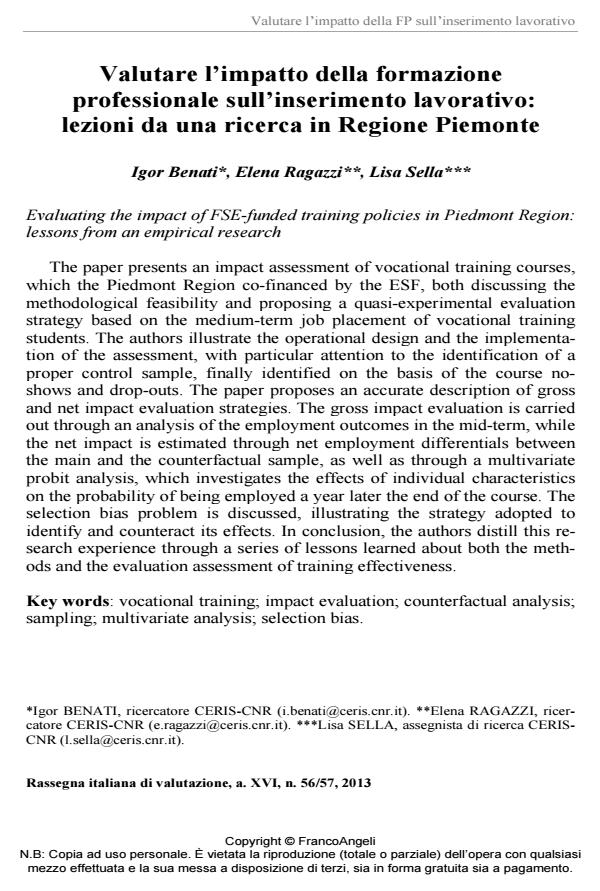Valutare l’impatto della formazione professionale sull’inserimento lavorativo: lezioni da una ricerca in Regione Piemonte
Titolo Rivista RIV Rassegna Italiana di Valutazione
Autori/Curatori Igor Benati, Elena Ragazzi, Lisa Sella
Anno di pubblicazione 2014 Fascicolo 2013/56-57
Lingua Italiano Numero pagine 22 P. 26-47 Dimensione file 169 KB
DOI 10.3280/RIV2013-056003
Il DOI è il codice a barre della proprietà intellettuale: per saperne di più
clicca qui
Qui sotto puoi vedere in anteprima la prima pagina di questo articolo.
Se questo articolo ti interessa, lo puoi acquistare (e scaricare in formato pdf) seguendo le facili indicazioni per acquistare il download credit. Acquista Download Credits per scaricare questo Articolo in formato PDF

FrancoAngeli è membro della Publishers International Linking Association, Inc (PILA)associazione indipendente e non profit per facilitare (attraverso i servizi tecnologici implementati da CrossRef.org) l’accesso degli studiosi ai contenuti digitali nelle pubblicazioni professionali e scientifiche
The paper presents an impact assessment of vocational training courses, which the Piedmont Region co-financed by the ESF, both discussing the methodological feasibility and proposing a quasi-experimental evaluation strategy based on the medium-term job placement of vocational training students. The authors illustrate the operational design and the implementation of the assessment, with particular attention to the identification of a proper control sample, finally identified on the basis of the course noshows and drop-outs. The paper proposes an accurate description of gross and net impact evaluation strategies. The gross impact evaluation is carried out through an analysis of the employment outcomes in the mid-term, while the net impact is estimated through net employment differentials between the main and the counterfactual sample, as well as through a multivariate probit analysis, which investigates the effects of individual characteristics on the probability of being employed a year later the end of the course. The selection bias problem is discussed, illustrating the strategy adopted to identify and counteract its effects. In conclusion, the authors distill this research experience through a series of lessons learned about both the methods and the evaluation assessment of training effectiveness. Key words: vocational training; impact evaluation; counterfactual analysis; sampling; multivariate analysis; selection bias.
- Including adolescent migrants in school through VET approach: evidence from a pilot action in Italy Valentina Lamonica, Elena Ragazzi, Lisa Sella, in Empirical Research in Vocational Education and Training 6/2020
DOI: 10.1186/s40461-020-00092-x - I dati amministrativi per la valutazione delle politiche: riscontri dall'esperienza piemontese sul FSE Elena Ragazzi, Lisa Sella, in RIV Rassegna Italiana di Valutazione 60/2015 pp.123
DOI: 10.3280/RIV2014-060008 - Données administratives et évaluation des politiques régionales Elena Ragazzi, Lisa Sella, in Revue d’Économie Régionale & Urbaine /2018 pp.509
DOI: 10.3917/reru.182.0509
Igor Benati, Elena Ragazzi, Lisa Sella, Valutare l’impatto della formazione professionale sull’inserimento lavorativo: lezioni da una ricerca in Regione Piemonte in "RIV Rassegna Italiana di Valutazione" 56-57/2013, pp 26-47, DOI: 10.3280/RIV2013-056003